药剂英文试题及答案
- 格式:docx
- 大小:37.70 KB
- 文档页数:5
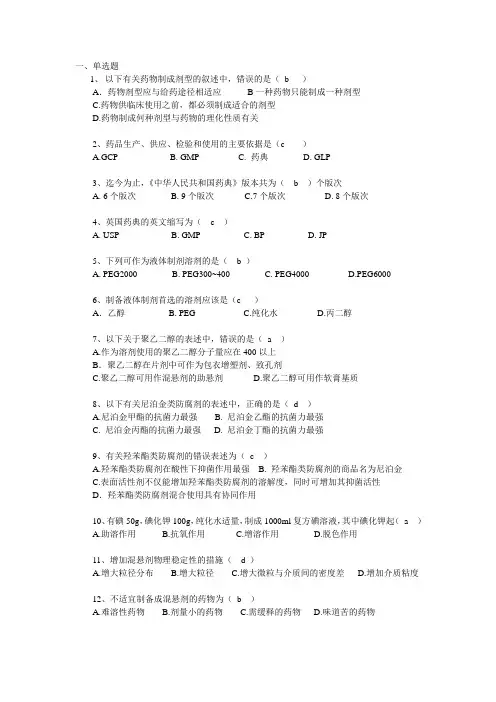
一、单选题
1、 以下有关药物制成剂型的叙述中,错误的是( b )
A.药物剂型应与给药途径相适应 B一种药物只能制成一种剂型
C.药物供临床使用之前,都必须制成适合的剂型
D.药物制成何种剂型与药物的理化性质有关
2、药品生产、供应、检验和使用的主要依据是(c )
A.GCP B. GMP C. 药典 D. GLP
3、迄今为止,《中华人民共和国药典》版本共为( b )个版次
A. 6个版次 B. 9个版次 C.7个版次 D. 8个版次
4、英国药典的英文缩写为( c )
A. USP B. GMP C. BP D. JP
5、下列可作为液体制剂溶剂的是( b )
A. PEG2000 B. PEG300~400 C. PEG4000 D.PEG6000
6、制备液体制剂首选的溶剂应该是(c )
A.乙醇 B. PEG C.纯化水 D.丙二醇
7、以下关于聚乙二醇的表述中,错误的是( a )
A.作为溶剂使用的聚乙二醇分子量应在400以上
B.聚乙二醇在片剂中可作为包衣增塑剂、致孔剂
C.聚乙二醇可用作混悬剂的助悬剂 D.聚乙二醇可用作软膏基质
8、以下有关尼泊金类防腐剂的表述中,正确的是( d )
A.尼泊金甲酯的抗菌力最强 B. 尼泊金乙酯的抗菌力最强
C. 尼泊金丙酯的抗菌力最强 D. 尼泊金丁酯的抗菌力最强
9、有关羟苯酯类防腐剂的错误表述为( c )
A.羟苯酯类防腐剂在酸性下抑菌作用最强 B. 羟苯酯类防腐剂的商品名为尼泊金
C.表面活性剂不仅能增加羟苯酯类防腐剂的溶解度,同时可增加其抑菌活性
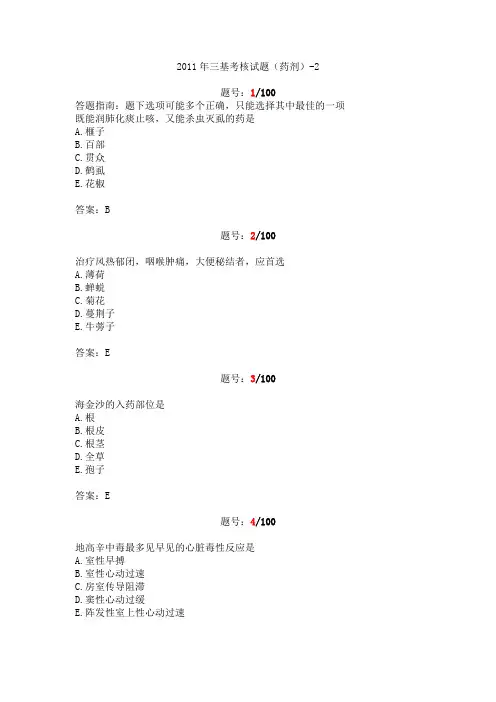
2011年三基考核试题(药剂)-2
题号:1/100
答题指南:题下选项可能多个正确,只能选择其中最佳的一项
既能润肺化痰止咳,又能杀虫灭虱的药是
A.榧子
B.百部
C.贯众
D.鹤虱
E.花椒
答案:B
题号:2/100
治疗风热郁闭,咽喉肿痛,大便秘结者,应首选
A.薄荷
B.蝉蜕
C.菊花
D.蔓荆子
E.牛蒡子
答案:E
题号:3/100
海金沙的入药部位是
A.根
B.根皮
C.根茎
D.全草
E.孢子
答案:E
题号:4/100
地高辛中毒最多见早见的心脏毒性反应是
A.室性早搏
B.室性心动过速
C.房室传导阻滞
D.窦性心动过缓
E.阵发性室上性心动过速
答案:A
题号:5/100
噻嗪类利尿药的作用部位是
A.髓袢升支粗段的髓质部
B.髓袢升支粗段的皮质部
C.髓袢降支
D.近曲小管
E.集合管及远曲小管
答案:B
题号:6/100
某两种药物联合应用,其作用大于各药单独作用的代数和,这种作用叫做
A.增强作用
B.相加作用
C.协同作用
D.互补作用
E.拮抗作用
答案:A
题号:7/100
外用具有拔毒生肌,杀虫止痒功效的药物是
A.升药
B.砒石
C.铅丹
D.炉甘石
E.轻粉
答案:C
题号:8/100
能选择性干扰RNA穿过宿主细胞,抑制病毒脱壳及核酸释放的抗病毒药物为
A.碘苷
B.金刚烷胺
C.阿昔洛韦
D.利巴韦林
E.阿糖腺苷
答案:B
题号:9/100
下列药物中,何药善治厥阴头痛
A.白芷
B.藁本
C.细辛
D.吴茱萸
E.葛根
答案:D
题号:10/100
强心苷的药理作用的描述,正确的是
A.正性频率作用
B.负性肌力作用
C.有利尿作用
D.兴奋交感神经中枢
E.正性传导作用
答案:D
题号:11/100
尤善治风湿痹证属下部寒湿者的药物是
A.威灵仙
B.乌梢蛇
C.伸筋草
D.海风藤
E.独活
答案:E
题号:12/100
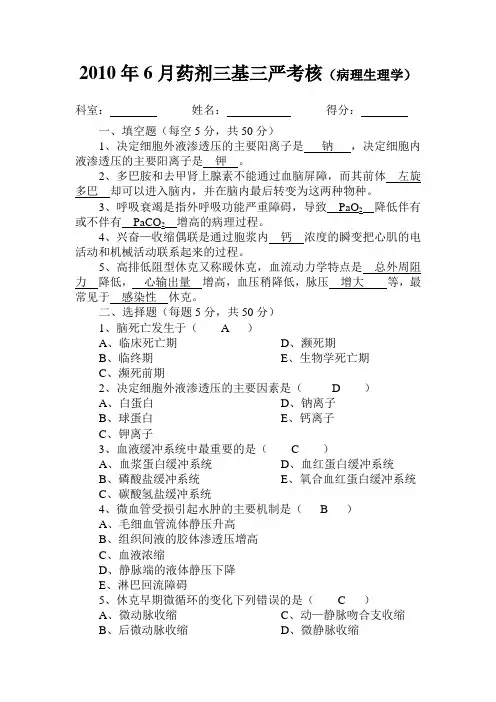
2010年6月药剂三基三严考核(病理生理学)
科室: 姓名: 得分:
一、填空题(每空5分,共50分)
1、决定细胞外液渗透压的主要阳离子是 钠 ,决定细胞内液渗透压的主要阳离子是 钾 。
2、多巴胺和去甲肾上腺素不能通过血脑屏障,而其前体 左旋多巴 却可以进入脑内,并在脑内最后转变为这两种物种。
3、呼吸衰竭是指外呼吸功能严重障碍,导致 PaO2 降低伴有或不伴有 PaCO2 增高的病理过程。
4、兴奋—收缩偶联是通过胞浆内 钙 浓度的瞬变把心肌的电活动和机械活动联系起来的过程。
5、高排低阻型休克又称暖休克,血流动力学特点是 总外周阻力 降低, 心输出量 增高,血压稍降低,脉压 增大 等,最常见于 感染性 休克。
二、选择题(每题5分,共50分)
1、脑死亡发生于( A )
A、临床死亡期
B、临终期
C、濒死前期 D、濒死期
E、生物学死亡期
2、决定细胞外液渗透压的主要因素是( D )
A、白蛋白
B、球蛋白
C、钾离子 D、钠离子
E、钙离子
3、血液缓冲系统中最重要的是( C )
A、血浆蛋白缓冲系统
B、磷酸盐缓冲系统
C、碳酸氢盐缓冲系统 D、血红蛋白缓冲系统
E、氧合血红蛋白缓冲系统
4、微血管受损引起水肿的主要机制是( B )
A、毛细血管流体静压升高
B、组织间液的胶体渗透压增高
C、血液浓缩
D、静脉端的液体静压下降
E、淋巴回流障碍
5、休克早期微循环的变化下列错误的是( C )
A、微动脉收缩
B、后微动脉收缩 C、动—静脉吻合支收缩
D、微静脉收缩 E、毛细血管前括约肌收缩
6、休克时血压下降的主要机制是( C )
A、心功能不全
B、外周动脉紧张度不足
C、微循环障碍而回心血量不足
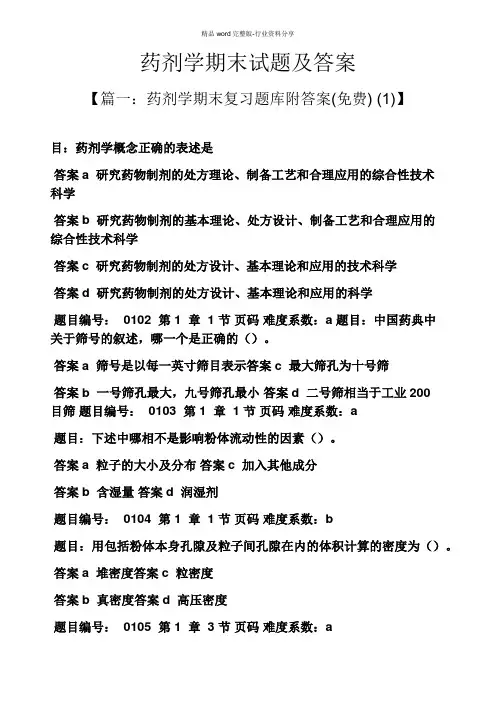
精品word完整版-行业资料分享
药剂学期末试题及答案
【篇一:药剂学期末复习题库附答案(免费) (1)】
目:药剂学概念正确的表述是
答案a 研究药物制剂的处方理论、制备工艺和合理应用的综合性技术科学
答案b 研究药物制剂的基本理论、处方设计、制备工艺和合理应用的综合性技术科学
答案c 研究药物制剂的处方设计、基本理论和应用的技术科学
答案d 研究药物制剂的处方设计、基本理论和应用的科学
题目编号: 0102 第 1 章 1 节 页码 难度系数:a 题目:中国药典中关于筛号的叙述,哪一个是正确的()。
答案a 筛号是以每一英寸筛目表示答案c 最大筛孔为十号筛
答案b 一号筛孔最大,九号筛孔最小 答案d 二号筛相当于工业200目筛 题目编号: 0103 第 1 章 1 节 页码 难度系数:a
题目:下述中哪相不是影响粉体流动性的因素()。
答案a 粒子的大小及分布 答案c 加入其他成分
答案b 含湿量 答案d 润湿剂
题目编号: 0104 第 1 章 1 节 页码 难度系数:b
题目:用包括粉体本身孔隙及粒子间孔隙在内的体积计算的密度为()。
答案a 堆密度答案c 粒密度
答案b 真密度答案d 高压密度
题目编号: 0105 第 1 章 3 节 页码 难度系数:a 精品word完整版-行业资料分享
题目:下列关于胶囊剂的叙述哪一条不正确()。
答案a 吸收好,生物利用度高 答案c 可避免肝的首过效应 答案b 可提高药物的稳定性 答案d 可掩盖药物的不良嗅味
题目编号: 0106 第 1 章 1 节 页码 难度系数:b
题目:配制含毒剧药物散剂时,为使其均匀混合应采用()。
答案a 过筛法 答案c 搅拌法
答案b 振摇法 答案d 等量递增法
题目编号: 0107 第 1 章 1 节 页码 难度系数:c
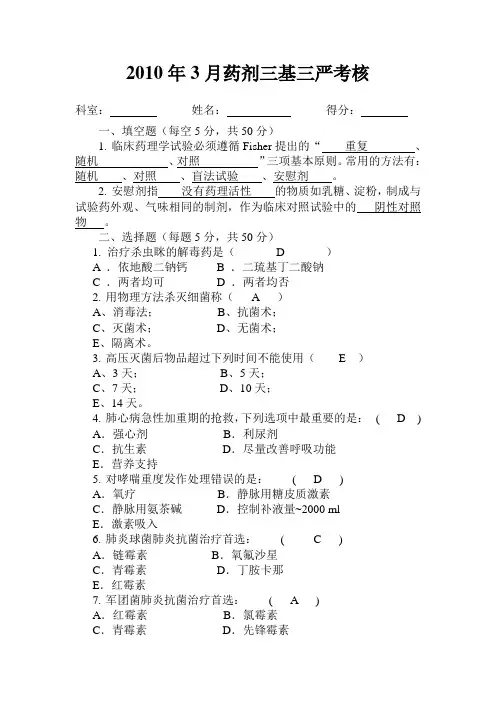
2010年3月药剂三基三严考核
科室: 姓名: 得分:
一、填空题(每空5分,共50分)
1. 临床药理学试验必须遵循Fisher提出的“ 重复 、随机 、对照 ”三项基本原则。常用的方法有:随机 、对照 、盲法试验 、安慰剂 。
2. 安慰剂指 没有药理活性 的物质如乳糖、淀粉,制成与试验药外观、气味相同的制剂,作为临床对照试验中的 阴性对照物 。
二、选择题(每题5分,共50分)
1. 治疗杀虫眯的解毒药是( D )
A .依地酸二钠钙 B .二琉基丁二酸钠
C .两者均可 D .两者均否
2. 用物理方法杀灭细菌称( A )
A、消毒法; B、抗菌术;
C、灭菌术; D、无菌术;
E、隔离术。
3. 高压灭菌后物品超过下列时间不能使用( E )
A、3天; B、5天;
C、7天; D、10天;
E、14天。
4. 肺心病急性加重期的抢救,下列选项中最重要的是: ( D )
A.强心剂 B.利尿剂
C.抗生素 D.尽量改善呼吸功能
E.营养支持
5. 对哮喘重度发作处理错误的是: ( D )
A.氧疗 B.静脉用糖皮质激素
C.静脉用氨茶碱 D.控制补液量~2000 ml
E.激素吸入
6. 肺炎球菌肺炎抗菌治疗首选: ( C )
A.链霉素 B.氧氟沙星
C.青霉素 D.丁胺卡那
E.红霉素
7. 军团菌肺炎抗菌治疗首选: ( A )
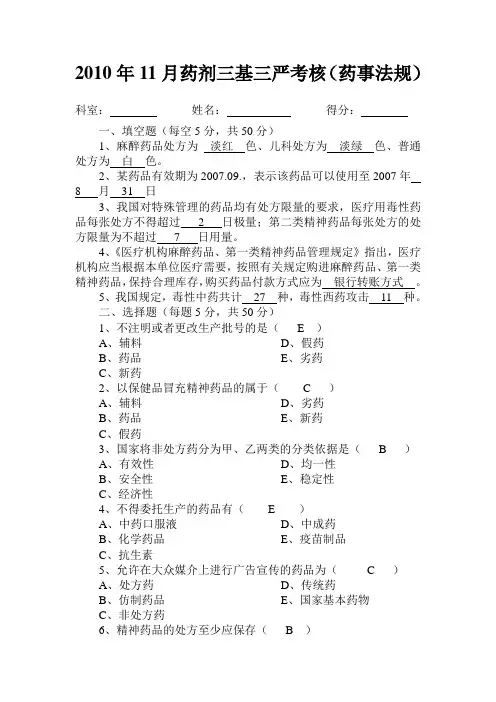
2010年11月药剂三基三严考核(药事法规)
科室: 姓名: 得分:
一、填空题(每空5分,共50分)
1、麻醉药品处方为 淡红 色、儿科处方为 淡绿 色、普通处方为 白 色。
2、某药品有效期为2007.09.,表示该药品可以使用至2007年
8 月 31 日
3、我国对特殊管理的药品均有处方限量的要求,医疗用毒性药品每张处方不得超过 2 日极量;第二类精神药品每张处方的处方限量为不超过 7 日用量。
4、《医疗机构麻醉药品、第一类精神药品管理规定》指出,医疗机构应当根据本单位医疗需要,按照有关规定购进麻醉药品、第一类精神药品,保持合理库存,购买药品付款方式应为 银行转账方式 。
5、我国规定,毒性中药共计 27 种,毒性西药攻击 11 种。
二、选择题(每题5分,共50分)
1、不注明或者更改生产批号的是( E )A、辅料
B、药品
C、新药 D、假药
E、劣药
2、以保健品冒充精神药品的属于( C )
A、辅料
B、药品
C、假药 D、劣药
E、新药
3、国家将非处方药分为甲、乙两类的分类依据是( B )
A、有效性
B、安全性
C、经济性 D、均一性
E、稳定性
4、不得委托生产的药品有( E )
A、中药口服液
B、化学药品
C、抗生素 D、中成药
E、疫苗制品
5、允许在大众媒介上进行广告宣传的药品为( C )
A、处方药
B、仿制药品
C、非处方药 D、传统药
E、国家基本药物
6、精神药品的处方至少应保存( B ) A、1年
B、2年
C、3年 D、4年
E、5年
7、盐酸哌替啶的管理规定是( A )
A、处方为一次用量,药品仅限于医疗机构内使用
B、处方为2日用量,药品仅限于医疗机构内使用
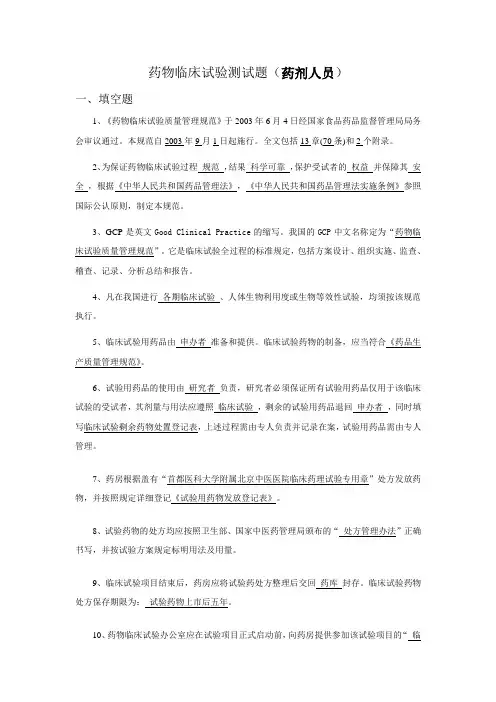
药物临床试验测试题(药剂人员)
一、填空题
1、《药物临床试验质量管理规范》于2003年6月4日经国家食品药品监督管理局局务会审议通过。本规范自2003年9月1日起施行。全文包括13章(70条)和2个附录。
2、为保证药物临床试验过程 规范 ,结果 科学可靠 ,保护受试者的 权益 并保障其 安全 ,根据《中华人民共和国药品管理法》,《中华人民共和国药品管理法实施条例》参照国际公认原则,制定本规范。
3、GCP是英文Good Clinical Practice的缩写。我国的GCP中文名称定为“药物临床试验质量管理规范”。它是临床试验全过程的标准规定,包括方案设计、组织实施、监查、稽查、记录、分析总结和报告。
4、凡在我国进行 各期临床试验 、人体生物利用度或生物等效性试验,均须按该规范执行。
5、临床试验用药品由 申办者 准备和提供。临床试验药物的制备,应当符合《药品生产质量管理规范》。
6、试验用药品的使用由 研究者 负责,研究者必须保证所有试验用药品仅用于该临床试验的受试者,其剂量与用法应遵照 临床试验 ,剩余的试验用药品退回 申办者 ,同时填写临床试验剩余药物处置登记表,上述过程需由专人负责并记录在案,试验用药品需由专人管理。
7、药房根据盖有“首都医科大学附属北京中医医院临床药理试验专用章”处方发放药物,并按照规定详细登记《试验用药物发放登记表》。
8、试验药物的处方均应按照卫生部、国家中医药管理局颁布的“ 处方管理办法”正确书写,并按试验方案规定标明用法及用量。
9、临床试验项目结束后,药房应将试验药处方整理后交回 药库 封存。临床试验药物处方保存期限为: 试验药物上市后五年。
10、药物临床试验办公室应在试验项目正式启动前,向药房提供参加该试验项目的“ 临床试验医师 签字表”。
11、所有以人为对象的研究必须符合《世界医学大会赫尔辛基宣言》,即公正、尊重人格、力求使受试者最大程度受益和尽可能避免伤害。
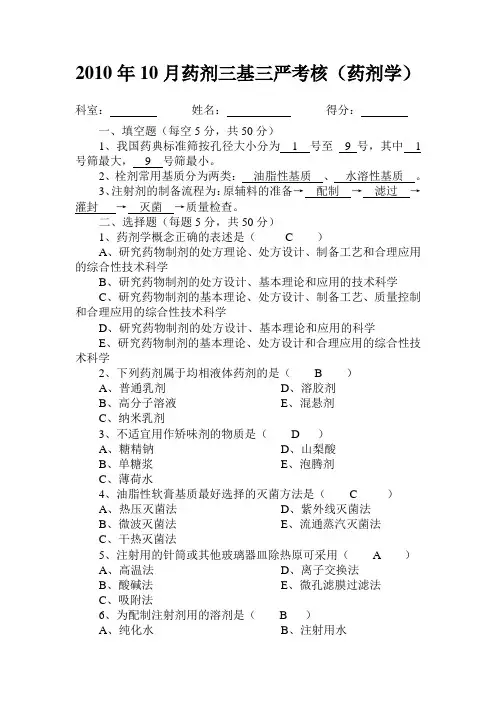
2010年10月药剂三基三严考核(药剂学)
科室: 姓名: 得分:
一、填空题(每空5分,共50分)
1、我国药典标准筛按孔径大小分为 1 号至 9 号,其中 1
号筛最大, 9 号筛最小。
2、栓剂常用基质分为两类: 油脂性基质 、 水溶性基质 。
3、注射剂的制备流程为:原辅料的准备→ 配制 → 滤过 →
灌封 → 灭菌 →质量检查。
二、选择题(每题5分,共50分)
1、药剂学概念正确的表述是( C )
A、研究药物制剂的处方理论、处方设计、制备工艺和合理应用的综合性技术科学
B、研究药物制剂的处方设计、基本理论和应用的技术科学
C、研究药物制剂的基本理论、处方设计、制备工艺、质量控制和合理应用的综合性技术科学
D、研究药物制剂的处方设计、基本理论和应用的科学
E、研究药物制剂的基本理论、处方设计和合理应用的综合性技术科学
2、下列药剂属于均相液体药剂的是( B )
A、普通乳剂
B、高分子溶液
C、纳米乳剂 D、溶胶剂
E、混悬剂
3、不适宜用作矫味剂的物质是( D )
A、糖精钠
B、单糖浆
C、薄荷水 D、山梨酸
E、泡腾剂
4、油脂性软膏基质最好选择的灭菌方法是( C )
A、热压灭菌法
B、微波灭菌法
C、干热灭菌法 D、紫外线灭菌法
E、流通蒸汽灭菌法
5、注射用的针筒或其他玻璃器皿除热原可采用( A )
A、高温法
B、酸碱法
C、吸附法 D、离子交换法
E、微孔滤膜过滤法
6、为配制注射剂用的溶剂是( B )
A、纯化水 B、注射用水 C、灭菌蒸馏水
D、灭菌注射用水 E、制药用水
7、包糖衣时包隔离层的主要材料是( E )
A、糖浆和滑石粉
B、稍稀的糖浆
C、食用色素 D、川蜡
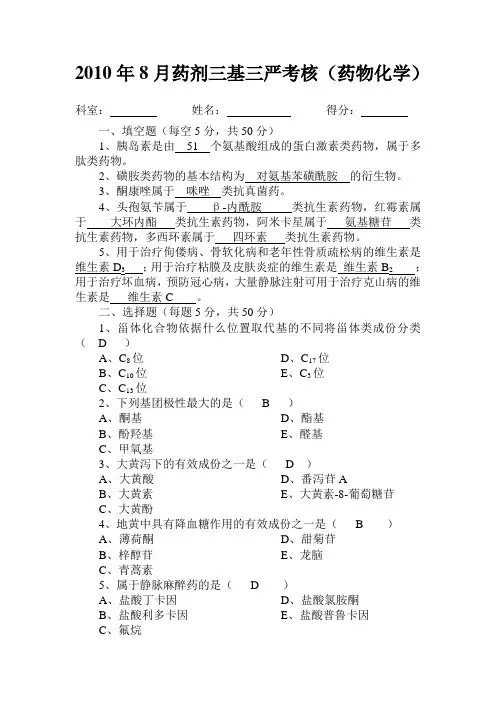
2010年8月药剂三基三严考核(药物化学)
科室: 姓名: 得分:
一、填空题(每空5分,共50分)
1、胰岛素是由 51 个氨基酸组成的蛋白激素类药物,属于多肽类药物。
2、磺胺类药物的基本结构为 对氨基苯磺酰胺 的衍生物。
3、酮康唑属于 咪唑 类抗真菌药。
4、头孢氨苄属于 β-内酰胺 类抗生素药物,红霉素属于 大环内酯 类抗生素药物,阿米卡星属于 氨基糖苷 类抗生素药物,多西环素属于 四环素 类抗生素药物。
5、用于治疗佝偻病、骨软化病和老年性骨质疏松病的维生素是维生素D3 ;用于治疗粘膜及皮肤炎症的维生素是 维生素B2 ;用于治疗坏血病,预防冠心病,大量静脉注射可用于治疗克山病的维生素是 维生素C 。
二、选择题(每题5分,共50分)
1、甾体化合物依据什么位置取代基的不同将甾体类成份分类( D )
A、C8位
B、C10位
C、C13位 D、C17位
E、C3位
2、下列基团极性最大的是( B )
A、酮基
B、酚羟基
C、甲氧基 D、酯基
E、醛基
3、大黄泻下的有效成份之一是( D )
A、大黄酸
B、大黄素
C、大黄酚 D、番泻苷A
E、大黄素-8-葡萄糖苷
4、地黄中具有降血糖作用的有效成份之一是( B )
A、薄荷酮
B、梓醇苷
C、青蒿素 D、甜菊苷
E、龙脑
5、属于静脉麻醉药的是( D )
A、盐酸丁卡因
B、盐酸利多卡因
C、氟烷 D、盐酸氯胺酮
E、盐酸普鲁卡因 6、久置空气中容易吸收二氧化碳而产生浑浊或沉淀,最好在临用前配制的药物是( C )
A、盐酸氯丙嗪
B、奥卡西平
C、苯妥英钠 D、丙戊酸钠
E、奋乃静
7、盐酸吗啡注射液放置过久,颜色会变深,是由于发生了( D )
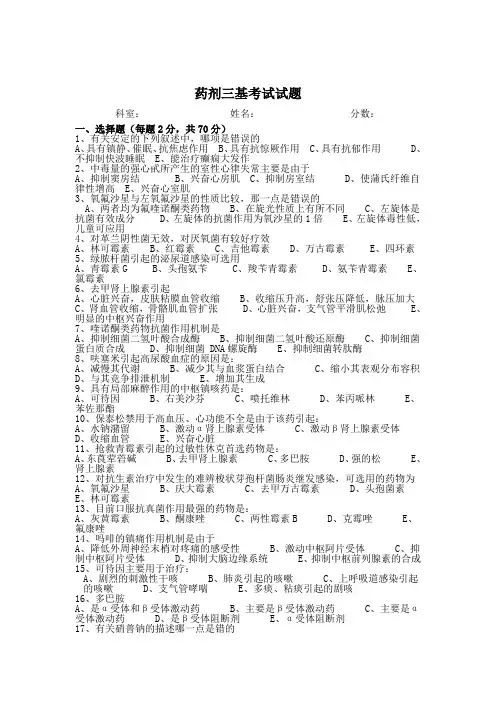
药剂三基考试试题
科室: 姓名: 分数:
一、选择题(每题2分,共70分)
1、有关安定的下列叙述中,哪项是错误的
A、具有镇静、催眠、抗焦虑作用 B、具有抗惊厥作用 C、具有抗郁作用 D、不抑制快波睡眠 E、能治疗癫痫大发作
2、中毒量的强心甙所产生的室性心律失常主要是由于
A、抑制窦房结 B、兴奋心房肌 C、抑制房室结 D、使蒲氏纤维自律性增高 E、兴奋心室肌
3、氧氟沙星与左氧氟沙星的性质比较,那一点是错误的
A、两者均为氟喹诺酮类药物 B、在旋光性质上有所不同 C、左旋体是抗菌有效成分 D、左旋体的抗菌作用为氧沙星的1倍 E、左旋体毒性低,儿童可应用
4、对革兰阴性菌无效,对厌氧菌有较好疗效
A、林可霉素 B、红霉素 C、吉他霉素 D、万古霉素 E、四环素
5、绿脓杆菌引起的泌尿道感染可选用
A、青霉素G B、头孢氨苄 C、羧苄青霉素 D、氨苄青霉素 E、氯霉素
6、去甲肾上腺素引起
A、心脏兴奋,皮肤粘膜血管收缩 B、收缩压升高,舒张压降低,脉压加大
C、肾血管收缩,骨骼肌血管扩张 D、心脏兴奋,支气管平滑肌松弛 E、明显的中枢兴奋作用
7、喹诺酮类药物抗菌作用机制是
A、抑制细菌二氢叶酸合成酶 B、抑制细菌二氢叶酸还原酶 C、抑制细菌蛋白质合成 D、抑制细菌 DNA螺旋酶 E、抑制细菌转肽酶
8、呋塞米引起高尿酸血症的原因是:
A、减慢其代谢 B、减少其与血浆蛋白结合 C、缩小其表观分布容积
D、与其竞争排泄机制 E、增加其生成
9、具有局部麻醉作用的中枢镇咳药是:
A、可待因 B、右美沙芬 C、喷托维林 D、苯丙哌林 E、苯佐那酯
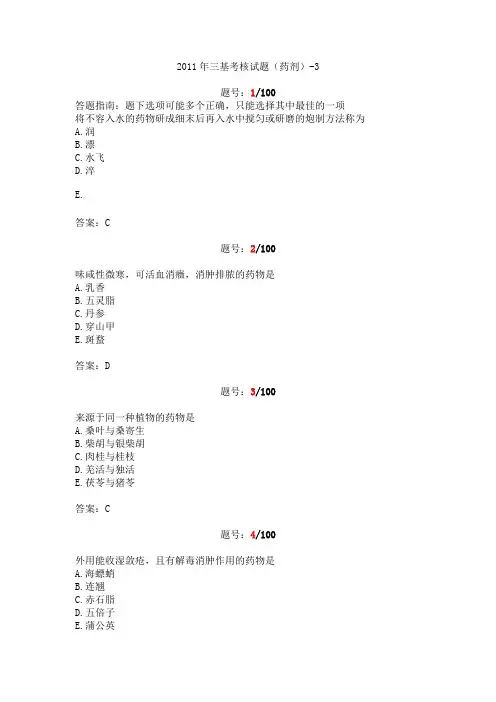
2011年三基考核试题(药剂)-3
题号:1/100
答题指南:题下选项可能多个正确,只能选择其中最佳的一项
将不容入水的药物研成细末后再入水中搅匀或研磨的炮制方法称为
A.润
B.漂
C.水飞
D.淬
E.
答案:C
题号:2/100
味咸性微寒,可活血消癥,消肿排脓的药物是
A.乳香
B.五灵脂
C.丹参
D.穿山甲
E.斑蝥
答案:D
题号:3/100
来源于同一种植物的药物是
A.桑叶与桑寄生
B.柴胡与银柴胡
C.肉桂与桂枝
D.羌活与独活
E.茯苓与猪苓
答案:C
题号:4/100
外用能收湿敛疮,且有解毒消肿作用的药物是
A.海螵蛸
B.连翘
C.赤石脂
D.五倍子
E.蒲公英
答案:D
题号:5/100
甲氧氯普胺(胃复安)具有强大的中枢性镇吐作用,这是因为
A.阻滞了多巴胺受体
B.激活了多巴胺受体
C.阻滞了吗啡受体
D.激活了吗啡受体
E.阻滞了H1受体
答案:A
题号:6/100
与乌头相反的药物应除外
A.玄参
B.白及
C.贝母
D.瓜蒌
E.半夏
答案:A
题号:7/100
川乌的性味是
A.辛、苦、寒
B.辛、苦、平
C.辛、甘、热
D.辛、咸、温
E.辛、苦、热
答案:E
题号:8/100
无对抗醛固酮作用的利尿药是
A.氨苯蝶啶
B.呋塞米
C.螺内酯
D.乙酰唑胺
E.氢氯噻嗪
答案:A
题号:9/100
下列关于氯丙嗪的说法,错误的是
A.长期应用易产生耐受性
B.精神病人服用后多数临床缓解,约有半数可获临床痊愈,显著减少复发
C.氯丙嗪有较强的镇静作用,对躁狂症的躁狂、激惹、敌对情绪等也有效
D.氯丙嗪的作用机制主要与其阻断中脑边缘系统及中脑-皮层通路的DA2 受体有关
E.本品对DA1受体、5-HT受体、M-型胆碱受体、α-肾上腺素受体均有阻 断作用,故作用广泛
答案:A
题号:10/100
我国封建社会最后一部官修本草是
A.《本草纲目》
2019年第三季度药剂三基考试
科室: 姓名: 得分
一、单选题(每题3分,共75分)
1、有关安定的下列叙述中,哪项是错误的(D)
A、具有镇静、催眠、抗焦虑作用B、具有抗惊厥作用C、具有抗郁作用D、不抑制快波睡眠
E、能治疗癫痫大发作
2、药物的首过效应是(B)
A、药物于血浆蛋白结合 B、肝脏对药物的转化C、口服药物后对胃的刺激
D、肌注药物后对组织的刺激E、皮肤给药后药物的吸收作用
3、中毒量的强心甙所产生的室性心律失常主要是由于(D)
A、抑制窦房结B、兴奋心房肌C、抑制房室结 D、使蒲氏纤维自律性增高E、兴奋心室肌
4、氧氟沙星与左氧氟沙星的性质比较,那一点是错误的(E)
A、两者均为氟喹诺酮类药物B、在旋光性质上有所不同C、左旋体是抗菌有效成分D、左旋体的抗菌作用为氧沙星的1倍E、左旋体毒性低,儿童可应用
5、对革兰阴性菌无效,对厌氧菌有较好疗效(A)
A、林可霉素B、红霉素C、吉他霉素D、万古霉素E、四环素
6、绿脓杆菌引起的泌尿道感染可选用(C)
A、青霉素G B、头孢氨苄C、羧苄青霉素D、氨苄青霉素E、氯霉素
7、有毒宜先下久煎的药是D) A、朱砂 B、鸦胆子C、杏仁D、附子E、制半夏
8、左旋多巴治疗震颤麻痹的作用可被下列哪种药物拮抗(C)
A、 VitB1 B、 VitB2 C、 VitB6 D、 VitB12 E、 VitE
9、某些药物口服,由于肠壁和肝脏的代谢,使其进入体循环的量减少,称(B)
A、生物利用度 B首过效 应 C、肝肠循环 D、酶的诱导 E、酶的抑制
10、钟乳石又称(B)
A、炉甘石 B、鹅管石 C、砒石 D、石燕 E、石膏
11、下列哪种药物不会导致耳毒性?(B)
A、呋塞米B、螺内酯C、依他尼酸D、布美他尼E、庆大霉素
12、强心甙减慢心房纤颤的心室率,是由于(B)
一、单选题
1、 以下有关药物制成剂型的叙述中,错误的是( b )
A.药物剂型应与给药途径相适应 B一种药物只能制成一种剂型
C.药物供临床使用之前,都必须制成适合的剂型
D.药物制成何种剂型与药物的理化性质有关
2、药品生产、供应、检验和使用的主要依据是(c )
A.GCP B. GMP C. 药典 D. GLP
3、迄今为止,《中华人民共和国药典》版本共为( b )个版次
A. 6个版次 B. 9个版次 C.7个版次 D. 8个版次
4、英国药典的英文缩写为( c )
A. USP B. GMP C. BP D. JP
5、下列可作为液体制剂溶剂的是( b )
A. PEG2000 B. PEG300~400 C. PEG4000 D.PEG6000
6、制备液体制剂首选的溶剂应该是(c )
A.乙醇 B. PEG C.纯化水 D.丙二醇
7、以下关于聚乙二醇的表述中,错误的是( a )
A.作为溶剂使用的聚乙二醇分子量应在400以上
B.聚乙二醇在片剂中可作为包衣增塑剂、致孔剂
C.聚乙二醇可用作混悬剂的助悬剂 D.聚乙二醇可用作软膏基质
8、以下有关尼泊金类防腐剂的表述中,正确的是( d )
A.尼泊金甲酯的抗菌力最强 B. 尼泊金乙酯的抗菌力最强
C. 尼泊金丙酯的抗菌力最强 D. 尼泊金丁酯的抗菌力最强
9、有关羟苯酯类防腐剂的错误表述为( c )
A.羟苯酯类防腐剂在酸性下抑菌作用最强 B. 羟苯酯类防腐剂的商品名为尼泊金
C.表面活性剂不仅能增加羟苯酯类防腐剂的溶解度,同时可增加其抑菌活性
2010年5月药剂三基三严考核(生物化学)
科室: 姓名: 得分:
一、填空题(每空5分,共50分)
1、维持蛋白质二级结构的化学键是 氢键 。
2、核酸对紫外线的最大吸收峰是在 260 nm。
3、嘌呤核苷酸的分解主要发生在 肝 、 小肠 及 肾 ,代谢终产物是 尿酸 。
4、氨基酸脱氨基作用的形式有 氧化脱氨基作用 ,转氨基作用 , 联合脱氨基作用 及 嘌呤核苷酸循环 。
二、选择题(每题5分,共50分)
1、取某蛋白质样品5mg,测得其中共含氮0.4mg,该样品蛋白质的百分含量是( B )
A、6.25%
B、50%
C、25% D、16.0%
E、5.0%
2、酶的共价修饰调节中最常见的修饰方式是( E )
A、腺苷化/脱腺苷化
B、甲基化/脱甲基化
C、糖苷化/脱糖苷化 D、-SH-/-S-S-
E、磷酸化/脱磷酸化
3、磺胺类药物的类似物是( A )
A、对氨基苯甲酸
B、四氢叶酸
C、二氢叶酸 D、叶酸
E、嘧啶
4、同工酶是指( B )
A、催化不同的化学反应,但酶蛋白分子的结构、理化性质、免疫学性质相同的一组酶。
B、催化相同的化学反应,但酶蛋白分子的结构、理化性质、免疫学性质不同的一组酶。
C、催化相同的化学反应,但酶蛋白分子的结构和免疫学性质相同、理化性质不同的一组酶。
D、催化不同的化学反应,但酶蛋白分子的结构相同、免疫学性质不同的一组酶。
E、催化相同的化学反应,但酶蛋白分子的结构相同、理化性质和免疫学性质不同的一组酶。
5、以下属于糖酵解的关键酶的是( A )
A、己糖激酶、6-磷酸果糖激酶-1、丙酮酸激酶 B、己糖激酶、6-磷酸果糖激酶-2、丙酮酸激酶
2010年2月药剂三基三严考核
科室: 姓名: 得分:
一、填空题(每空5分,共50分)
1.生物利用度是指药物吸收 速度 和 程度 的一种 量度 。
2. 稳态血药浓度是指以一定 时间 间隔,以相同的 剂量
多次给药,则在给药过程总血药浓度可 递加 ,直至血药浓度维持在 一定水平 或在 一定水平 上下波动,该范围称为稳态血药浓度。
3. 药时曲线是以 时间 为横坐标,以药物的一些特征 数量 为纵坐标而做出的各种曲线。
二、选择题(每题5分,共50分)
1. 对结核菌有杀菌力,但对细胞内结核菌的作用较小的是:
( C )
A.乙胺丁醇 B.对氨基水杨酸
C.链霉素 D.异烟肼
E.吡嗪酰胺
2. 甘露醇脱水治疗脑水肿应:( D )
A.快速静脉注射
B.一次剂量在2小时内滴完
C.一次剂量在1小时内滴完
D.一次剂量在15分钟内滴完
E.滴注速度与疗效无关
3. 精神病患者服用氯丙嗪出现急性锥体外系症状时,最合理的措施是( D )
A.停药 B.减量
C.减量加用左旋多巴 D.减量加用安坦
E.停药改用安坦
4. 敌百虫中毒禁忌使用哪种洗胃液( C )
A.生理盐水 B.温水
C. 2%碳酸氢钠 D.茶叶水
E. 1:5000高锰酸钾
5.对硫磷中毒禁忌使用哪种洗胃液( E )
A.生理盐水 B.温水
四 川 大 学 期 末 考 试 试 题
(2010 ——2011 学年第 一 学期)
课程号:302155020课序号: 课程名称:液压传动 任课教师:熊瑞平、傅波、刘苏 成绩:
适用专业年级: 08级机制专业 学生人数: 印题份数: 学号: 姓名:
考 试 须 知
四川大学学生参加由学校组织或由学校承办的各级各类考试,必须严格执行《四川大学考试工作管理办法》和《四川大学考场规则》。有考试违纪作弊行为的,一律按照《四川大学学生考试违纪作弊处罚条例》进行处理。
四川大学各级各类考试的监考人员,必须严格执行《四川大学考试工作管理办法》、《四川大学考场规则》和《四川大学监考人员职责》。有违反学校有关规定的,严格按照《四川大学教学事故认定及处理办法》进行处理。
Test of Fluid Power and Applications (A)
No. 1 2 3 4 5 6 Total
Score
1. Fill out the blanks.( 26%)
(1). Liquids are considered to be 不可压缩的 so that their volume does not change with pressure
changes. On the other hand , gases are fluids which are 可压缩的 so that their volume will vary to
fill the vessel containing them.(2%)
(2) Pascal’s law states that 作用在密闭流体里的压力大小相同朝各个方向传递 . (1%)
(3) The conservation of energy las states that 能量不会无故消失,也不会无故产生 .
药剂英文试题及答案
Pharmacology Exam Questions and Answers
Section A: Multiple Choice Questions (MCQs)
1. Which of the following is a side effect of beta-blockers?
A. Increased heart rate
B. Decreased blood pressure
C. Increased respiratory rate
D. Increased blood sugar levels
Answer: B. Decreased blood pressure
2. The primary mechanism of action of aspirin is:
A. Inhibition of acetylcholinesterase
B. Agonist activity at beta-adrenergic receptors
C. Inhibition of cyclooxygenase enzymes
D. Stimulation of prostaglandin synthesis
Answer: C. Inhibition of cyclooxygenase enzymes
3. Which class of drugs is used to treat Parkinson's disease?
A. Benzodiazepines
B. Antipsychotics
C. Dopaminergic agents
D. Anticholinergics
Answer: C. Dopaminergic agents
4. The therapeutic index is defined as:
A. The ratio of the minimum effective dose to the maximum
safe dose
B. The ratio of the maximum safe dose to the minimum toxic
dose
C. The ratio of the minimum toxic dose to the maximum
effective dose
D. The ratio of the minimum effective dose to the minimum
toxic dose
Answer: D. The ratio of the minimum effective dose to the
minimum toxic dose
5. The term "prodrug" refers to a substance that:
A. Is administered as a drug but must be metabolized to be
active
B. Is an active drug that is converted into a less active
metabolite
C. Is a drug that is immediately active upon
administration
D. Is a drug that is converted into a more potent form by
the body
Answer: A. Is administered as a drug but must be
metabolized to be active
Section B: Short Answer Questions
6. What is the difference between a receptor agonist and an
antagonist? Answer: A receptor agonist is a substance that binds to a
receptor and activates it, producing a biological response.
An antagonist, on the other hand, binds to a receptor but
does not activate it, and may block or reduce the effect of
an agonist.
7. Explain the concept of drug half-life.
Answer: The half-life of a drug is the time required for
the concentration of the drug in the body to decrease by half.
It is an important parameter in determining the dosing
interval for a medication.
8. What are the factors that can affect drug absorption?
Answer: Factors affecting drug absorption include the
chemical properties of the drug, the presence of food in the
gastrointestinal tract, the pH of the environment, and the
blood flow to the absorption site.
9. Describe the difference between a narrow therapeutic index
drug and a wide therapeutic index drug.
Answer: A drug with a narrow therapeutic index has a small
margin between its effective dose and toxic dose, requiring
careful dosing to avoid toxicity. A drug with a wide
therapeutic index has a larger margin between its effective
and toxic doses, allowing for greater dosing flexibility and
less risk of toxicity.
10. What is the role of the liver in drug metabolism?
Answer: The liver plays a crucial role in drug metabolism
by converting lipophilic drugs into more water-soluble
metabolites, which can then be more easily excreted by the kidneys. The liver contains various enzymes, particularly the
cytochrome P450 system, which are responsible for the
biotransformation of many drugs.
Section C: Essay Questions
11. Discuss the importance of pharmacokinetics in drug
therapy.
Answer: Pharmacokinetics is the study of how a drug is
absorbed, distributed, metabolized, and excreted by the body.
Understanding the pharmacokinetic properties of a drug is
essential for optimizing drug therapy, ensuring efficacy, and
minimizing adverse effects. It helps in determining the
appropriate dosing regimen, frequency, and duration of
treatment.
12. Explain the concept of drug-drug interactions and provide
examples.
Answer: Drug-drug interactions occur when two or more
drugs affect each other's action or metabolism. This can lead
to increased or decreased drug effects, or the development of
new side effects. Examples include the interaction between
warfarin and aspirin, where aspirin can enhance the
anticoagulant effect of warfarin, and the interaction between
phenytoin and isoniazid, where isoniazid can decrease the
effectiveness of phenytoin by inducing its metabolism.
13. Discuss the role of genetics in individual responses to
drugs.
Answer: Genetics can significantly influence an
individual's response to a drug. Genetic variations can